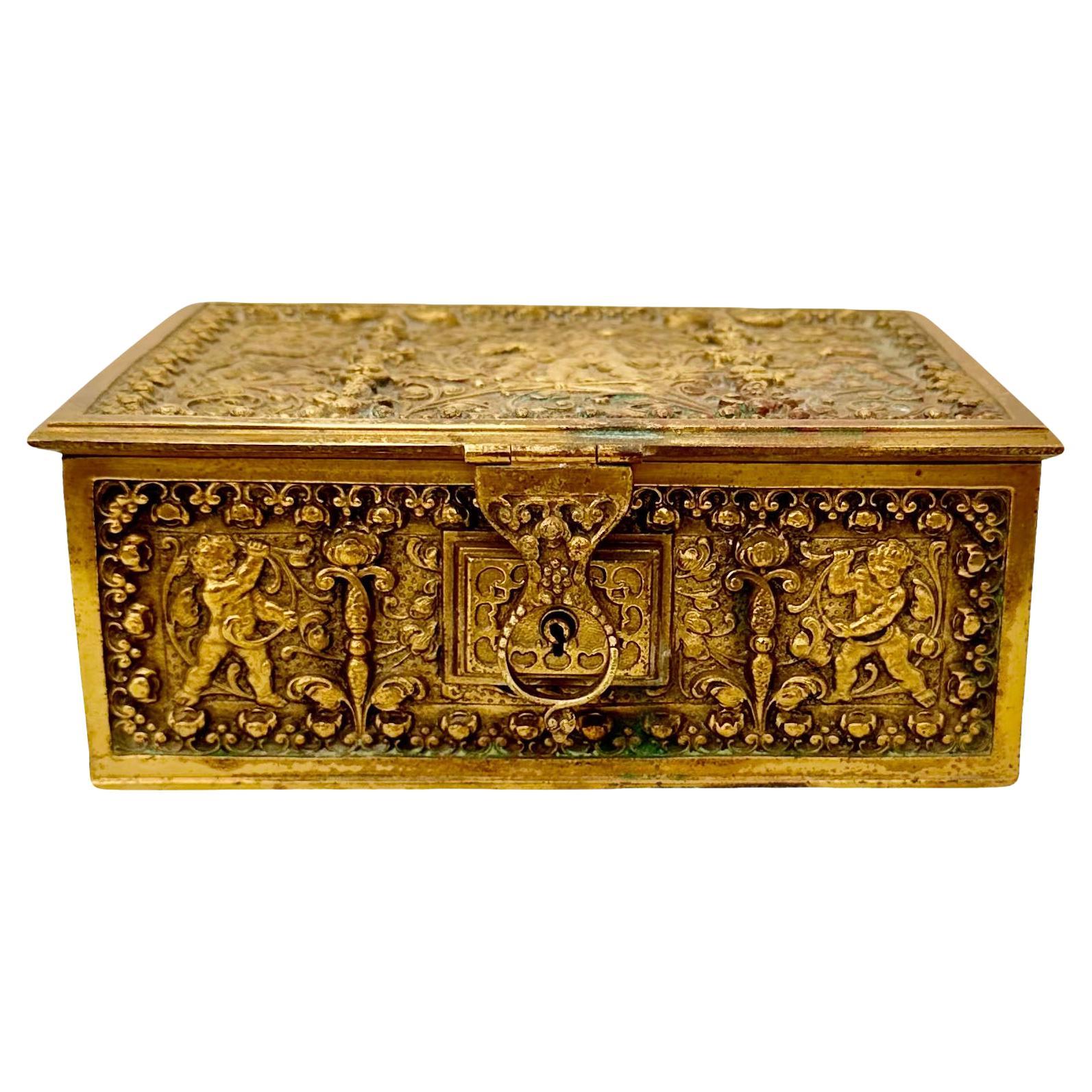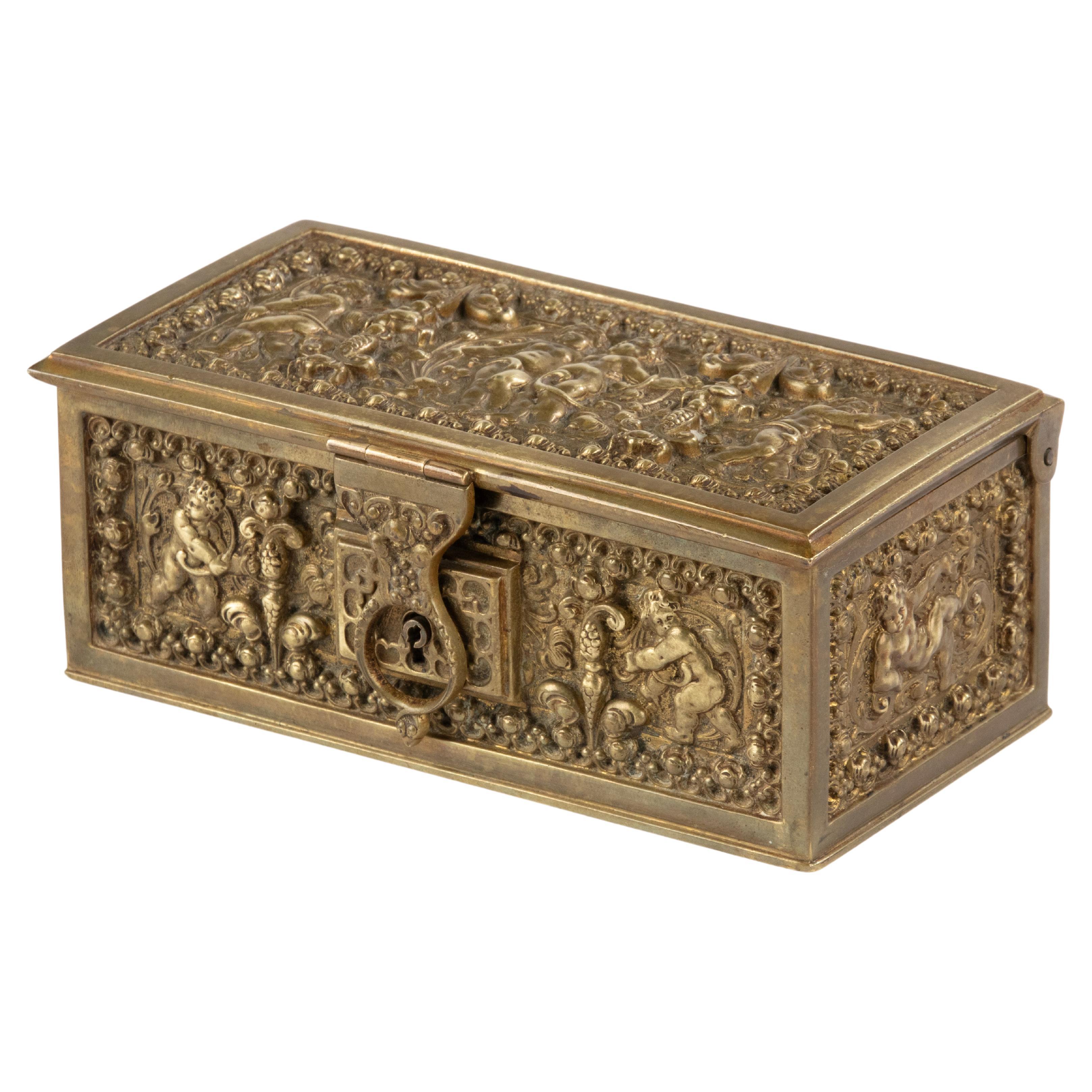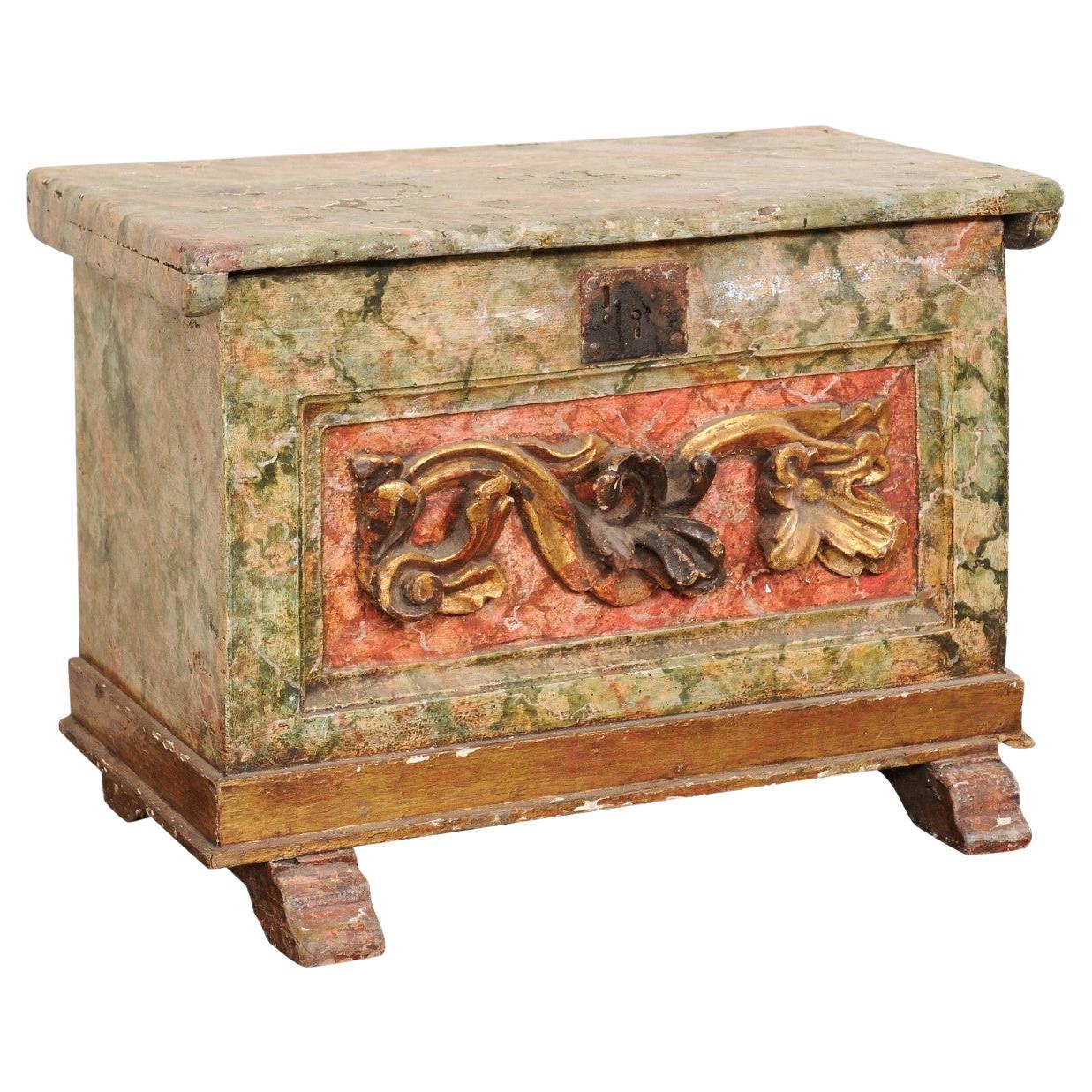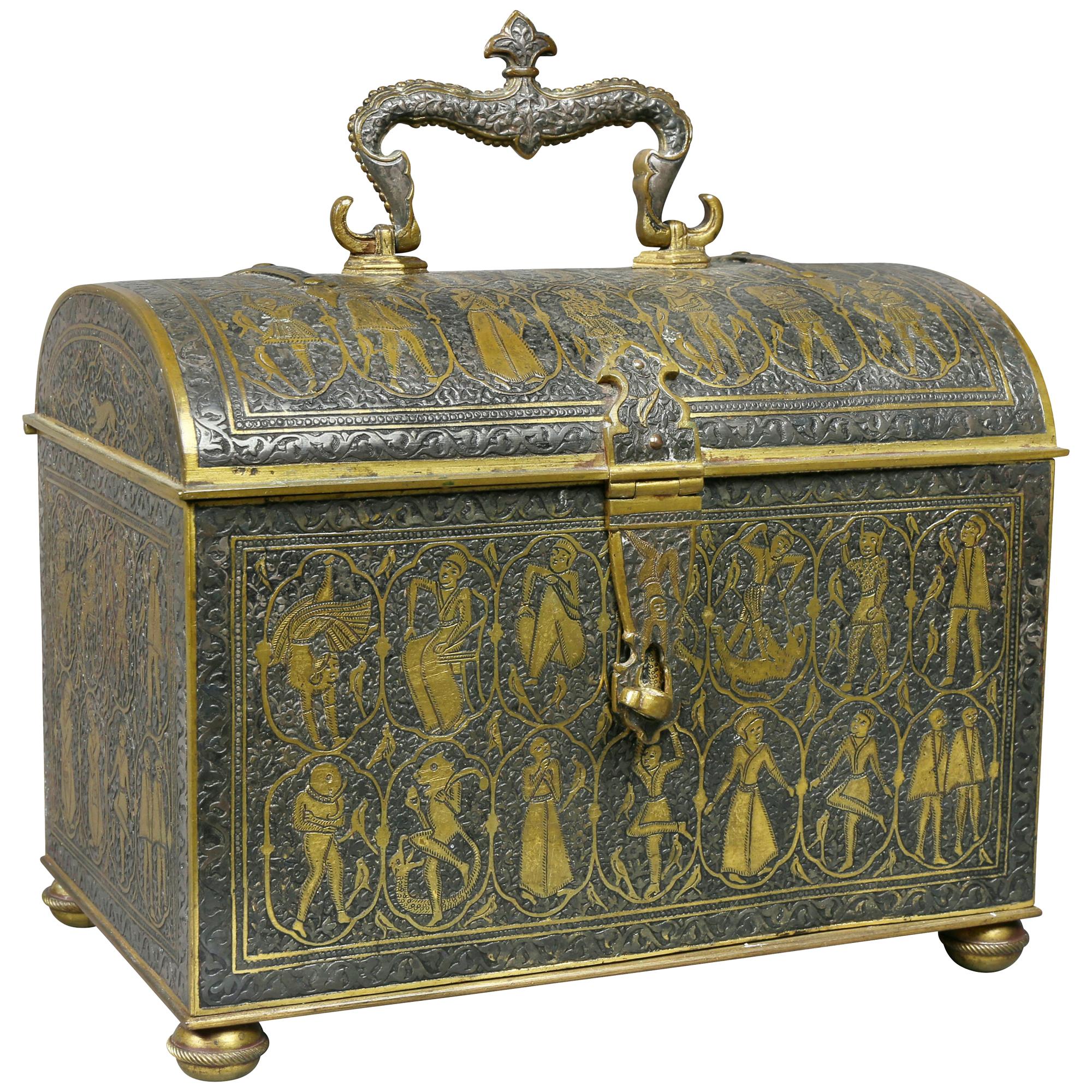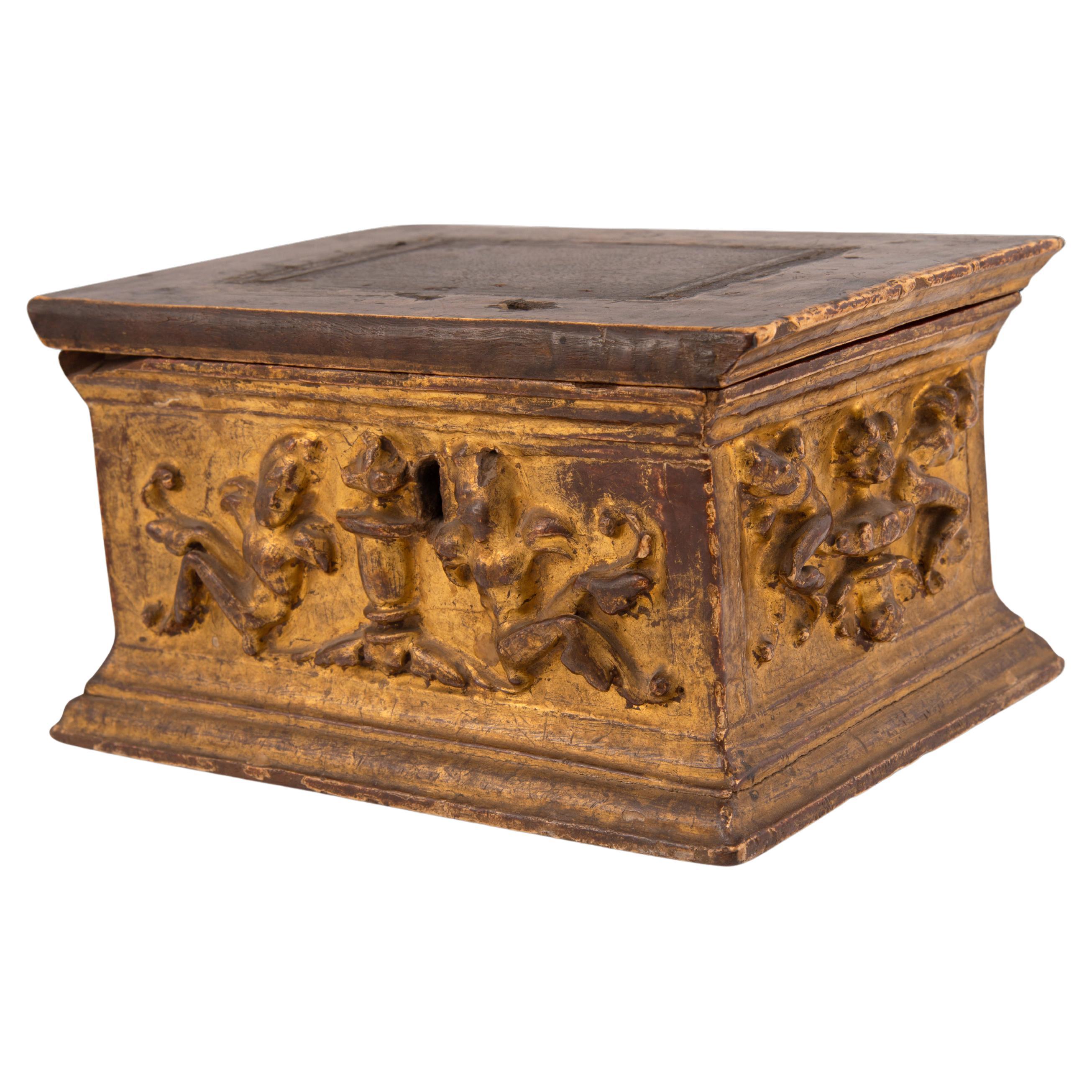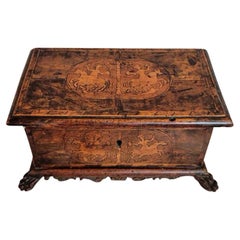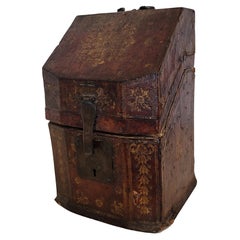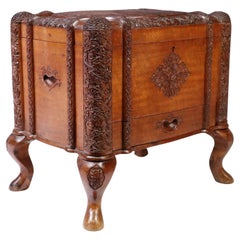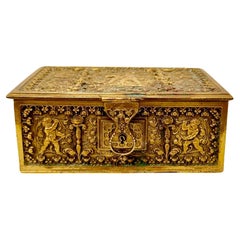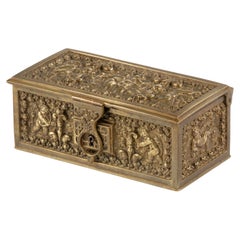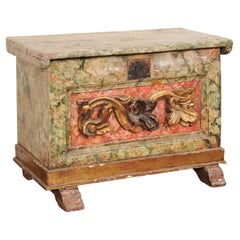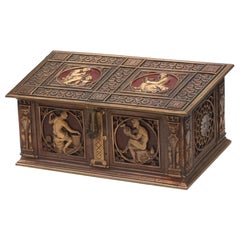Items Similar to Rare & Important 16th Century Italian Bronze Jacopo Lodovico del Duca Table Box
Want more images or videos?
Request additional images or videos from the seller
1 of 8
Rare & Important 16th Century Italian Bronze Jacopo Lodovico del Duca Table Box
$14,500
£10,759.56
€12,533.42
CA$20,184.11
A$22,476.82
CHF 11,697.94
MX$277,136.50
NOK 148,982.26
SEK 140,028.88
DKK 93,514.83
Shipping
Retrieving quote...The 1stDibs Promise:
Authenticity Guarantee,
Money-Back Guarantee,
24-Hour Cancellation
About the Item
A magnificent antique fall-front box with scarce Medieval period bronze lockplate and hasp attributed to Jacopo and Lodovico del Duca.
Featuring an important Lockplate and Hasp designed circa 1570, exact date of manufacture unknown, attributed to the late 16th century Roman foundry of Jacopo 1520-1604) and Ludovico (1551-1601) del Duca, with no apparent signatures or hallmarks which is typical of the era, but we did not remove it and inspect the back.
Boxes such as this hand various uses but were frequently used by merchants as a writing box - slope during travel and trade, as a small coffer - strong box for storing important documents, money and valuables, as well as a jewelry casket.
This hand-crafted European drop-front box dates to the late 19th century, signed L'PUPLET, adorned with a significantly older Italian fine quality cast bronze lockplate with intricate Renaissance era reliefs, including figures, coat-of-arms, and elongated hasp, mounted on a chest of drawers form solid wooden case, wrapped in exotic Japanesque embossed and gilded metallic paper, having a locking fall-front panel with original key included, opening to reveal three interior drawers, all lined in red velvet. circa 1875
The visually striking textured wallpaper covering the box's exterior displays bamboo, birds, and flowers in the oriental Japanesque taste popular in Europe in the 1860s and 1870s following the forced reopening of foreign trade with Japan in 1858 and the ensuing Japonisme craze.
To the interior of the fall front panel is a gilt circular stamp with the somewhat obscured name of the workshop or store (likely) "L'PUPLET" and the city "Burxelles" which is in Brussels, indicating the box was likely made or retailed there.
Marks to box:
L'PUPLET, BRUXELLES
Inscription:
13, 14, 15 (Interior drawers inscribed on the verso of their backboards in script from top to bottom, respectively)
Provenance / Acquisition:
The origin of the elaborate lockplate with hasp on the front of the piece is more intriguing. At least 76 lockplates of this design have been recorded in major museums, private collections, and in the antiques trade across the Western World. For example, lockplates of this pattern are in the collections of the Rijksmuseum in Amsterdam, the State Museum of Prussian Cultural Heritage in Berlin, the Museum Cicico in Bologna, The Museum of Fine Arts in Boston, the Dallas Museum of Art in Texas, the Victoria & Albert Museum in London, the Museo di Palazzo Venezia in Rome, the State Hermitage Museum in St. Petersburg, and the National Gallery of Art in Washington, DC.[1]
Specialists in Renaissance bronzes, especially Charles Avery and Lukas Madersbacher, have assembled robust inventories of such pieces and have attempted to decode the late Mannerist iconography, family coat-of-arms, and use of these amazing objects.[2] Madersbacker published a study in 2021 where he argues that the female figure on the hasp is that of Dovizia, a kind of 'house goddess' guaranteeing prosperity and fertility; and that this image was likely based on a prototype from the Italian Renaissance sculpture Donatello. The male-female pair of reclining, nude warriors who have cast off their armor above have not yet been identified, but according to Madersbacker fit well into an iconographic tradition of such pairings.[3]
Originally the use of such lockplates in the late 16th century was to ornament and secure travel chests in which wealthy individuals could transport their personal belongings as they moved between homes and other locations.[4] Many of the lockplates include the coats-of-arms of wealthy Italian families who owned them, and it is believed that a significant number of examples were made to celebrate marriages between powerful families. Others appear to have simply been made as luxury items to adorn and identify the owners travel chests. The coat-of-arms on the hasp is believed to be that of the Gras-Préville family of Italy and southern France.[5]
The exact dating and creator of this lockplate design has eluded scholars, but Madersbacker, building on the earlier work by Avery, argues that the earliest known example was made to commemorate a marriage that took place in Rome in 1569 and that such lockpates continued to be made in significant quantities until at least c. 1600.[6] He further postulates that this time period, along with the fact that most of the families who commissioned chests with this lockplate design lived in or were connected to Rome, suggest it is possible that they were produced in the shop of brothers Jacopo (c. 1520-1604) and Lodovico del Duca (active 1551-1601). Jacopo was well known at the time as a sculptor and architect who is most remembered for assisting Michelangelo with projects in Rome, including the sculpture and construction of the tomb of Pope Julius II.[7]
Several of these lockplates with hasps survive on their original domed-topped chests, but the vast majority do not. Rather, they were retained once the usefulness of the chests was over and subsequently introduced into the European antiques trade in the 19th century.[8] Furthermore, it is believed that later examples were made although the chronology for this work has not been delineated. This effort is hampered by the fact that some examples were never gilded or have lost their gilding and that there are variations in size between examples.[9]
While more work has yet to be done on these intriguing and beautiful objects, the original design remains one of the most beautiful and prolific of Renaissance Italy.
Drop-front caskets of this kind probably first appeared in Germany around the middle of the 16th century and soon became popular in Italy, the Iberian peninsula and elsewhere. Having various names depending on origin, time period, and intended use, they were frequently used by traveling merchants as a portable writing slope - lap desk while traveling for trade, by weathy upper-class businessmen and elites as a coffer keeping safe important documents, coins, and valuables, and later as a strong box, jewel casket, tea caddy, decorative table box, etc...
1. Charles Avery, "Fontainebleau, Milan, or Rome?: A Mannerist Bronze Lockplate and Hasp", Studies in the History of Art, vol. 2, Symposium Papers IX: Italian Plaquettes (Washington, DC: National Gallery of Art, 1989), pp. 291-305
2. Charles Avery, "Fontainebleau, Milan, or Rome? A Mannerist Bronze Lockplate and Hasp" Studies in Italian Sculpture (London: 2001), pp. 339-86 (this is an extended version of his 1989 article of the same title); and Lukas Madersbacher, "Armorial Lockplates: A Story of Success in Renaissance Rome", The Rijksmuseum Bulletin, vol. 69, no. 4 (Amsterdam: Rijksmuseum, 2021), pp. 303-303-321.
3. Madersbacher, pp. 303-304.
4. Ibid., p. 305.
5. For an example with the same coat-of-arms see, Charles L. Venable, Decorative Arts Highlights from the Wendy and Emery Reves Collection (Dallas: Dallas Museum of Art, 1995), p. 15.
6. Madersbacher, pp. 317-318.
7. For a very brief encapsulation of the artists life and work, see: the Wikipedia entry for "Giacomo del Duca".
8. For images of such surviving chests, see Madersbacher, p. 305.
9. Based on Avery's inventory the majority of these lockplates are about 18 cm. square, with larger and smaller variants on either side of that measurement. For one of the smallest examples, which some believe to be a 19th-century example after the original, see Christie's Auction Catalogue (London, 31 Nov. 2010), lot 423.
Acquired from highly reputable auction house Heritage Auctions, Dallas, Texas. Catalog: 2022 June Fine Furniture & Decorative Arts Signature Auction #8085.
Dimensions: (approx)
8.25" High, 7.5" Wide, 6" Deep
Condition Report:
Overall a remarkable museum quality example. Great antique condition with beautifully aged patina over the whole. Attractive appearance; strong, sturdy, stable, and structurally sound; with expected wear consistent with age, use, handling and exposure, including scattered nicks, chips and losses, evidence of old professional restorations, especially to interior drawers. Presents superbly, sure to add a touch of timeless elegant sophistication, refined warmth, and rich historical interest to any space!
- Dimensions:Height: 8.25 in (20.96 cm)Width: 7.5 in (19.05 cm)Depth: 6 in (15.24 cm)
- Style:Japonisme (Of the Period)
- Materials and Techniques:
- Place of Origin:
- Period:
- Date of Manufacture:circa 1580 and 1875
- Condition:Wear consistent with age and use. Minor losses. Overall remarkable museum quality example. Great antique condition with beautifully aged patina. Attractive appearance; structurally sound; expected wear consistent with age & use, scattered nicks, chips & losses, professional restoration to drawers.
- Seller Location:Forney, TX
- Reference Number:1stDibs: LU5977229376242
About the Seller
4.8
Platinum Seller
Premium sellers with a 4.7+ rating and 24-hour response times
Established in 2013
1stDibs seller since 2021
290 sales on 1stDibs
Typical response time: 1 hour
- ShippingRetrieving quote...Shipping from: Forney, TX
- Return Policy
Authenticity Guarantee
In the unlikely event there’s an issue with an item’s authenticity, contact us within 1 year for a full refund. DetailsMoney-Back Guarantee
If your item is not as described, is damaged in transit, or does not arrive, contact us within 7 days for a full refund. Details24-Hour Cancellation
You have a 24-hour grace period in which to reconsider your purchase, with no questions asked.Vetted Professional Sellers
Our world-class sellers must adhere to strict standards for service and quality, maintaining the integrity of our listings.Price-Match Guarantee
If you find that a seller listed the same item for a lower price elsewhere, we’ll match it.Trusted Global Delivery
Our best-in-class carrier network provides specialized shipping options worldwide, including custom delivery.More From This Seller
View All17th/18th Century Italian Venetian Marquetry Table Box
Located in Forney, TX
An important early antique Italian Renaissance table box, handcrafted in Northern Italy in the 17th/18th century, cassone chest form, richly inlaid, the top and front panel with fruitwood banding framing...
Category
Antique 18th Century Italian Renaissance Decorative Boxes
Materials
Wood, Fruitwood
18th Century Continental Baroque Period Gilt Tooled Leather Clad Knife Box
Located in Forney, TX
A scarce original antique European Baroque Period tooled leather clad cutlery caddy, circa 1740
Handcrafted in Continental Europe in the first half of...
Category
Antique 18th Century European Baroque Knife Boxes
Materials
Leather, Wood
Vintage European Leather Flatware Box Display Chest
Located in Forney, TX
A scarce Continental heavily distressed leather flatware storage box chest, 20th century, finely hand-crafted, rectangular solid wood case, domed ...
Category
20th Century European Decorative Boxes
Materials
Leather, Wood
Large Antique South Asian Colonial Carved Camphor Wood Table Box Jewelry Casket
Located in Forney, TX
A scarce antique circa 1900 South Asian hand carved wooden decorative table box / jewel casket.
Hand-crafted in the early 20th century, likely British Ceylon (present day Sri Lanka)...
Category
Early 20th Century South Asian Jewelry Boxes
Materials
Wood
Antique Spanish Colonial Period Leather Carved Cedar Travel Chest
Located in Forney, TX
A scarce 300-year-old Spanish Colonial period leather clad and carved travel chest with beautifully aged patina. circa 1725
Born in the first half o...
Category
Antique 17th Century Spanish Colonial Blanket Chests
Materials
Iron
Fine Antique English Toulmin & Gale Attrib Madagascar Ebony Stationary Box
By Toulmin & Gale
Located in Forney, TX
A stunning very fine quality antique English stationary box in striking exotic hardwood coromandel / madagascar ebony. circa 1880
Exquisitely hand-crafted in England in the 19th cen...
Category
Antique 19th Century English Victorian Decorative Boxes
Materials
Brass
You May Also Like
Renaissance Revival Style Bronze Box
Located in Tampa, FL
A renaissance revival style solid bronze box of the highest quality. The deep blue velvet interior has a ring holder. The interior depth is two and a half inches. No key. Austria, ci...
Category
Antique 1880s Austrian Decorative Boxes
Materials
Bronze
Late 19th Century Bronze Box - Putti - Renaissance Style
Located in Casteren, Noord-Brabant
A beautiful bronze box, decorated in renaissance style with putti and decorative ornaments.
The box is in good condition, key is missing. Beautiful colour and patina.
Dimensions: ...
Category
Antique 1890s French Renaissance Decorative Boxes
Materials
Brass, Bronze
18th C. Venetian Italian Wood Box w/its Original Finish, 26.5" Wide
Located in Atlanta, GA
A Venetian Italian box with its original finish, from the 18th century. This antique wood box from Italy is rectangular in shape with a raised foliate...
Category
Antique Early 18th Century Italian Decorative Boxes
Materials
Wood
Patinated and Parcel Gilt Humidor, Oscar Bach, (French/American)
Located in West Palm Beach, FL
Patinated and Parcel Gilt Humidor, Oscar Bach, (French/American)
circa 1920, unsigned. Rectangular, with a hinged lid, cast with roundels of allegories representing the arts, on a ...
Category
20th Century Decorative Boxes
Materials
Wood
Renaissance Revival Damacened and Bronze Casket
Located in Essex, MA
With a domed hinged lid and bail handle over a conforming case decorated overall with figures in Renaissance dress. Bun feet. Provenance; David and P...
Category
Antique 1650s European Renaissance Revival Decorative Boxes
Materials
Bronze
Chest. Carved wood, metal. Spanish school, 16th century.
Located in Madrid, ES
Chest. Carved wood, metal. Spanish school, 16th century.
Rectangular casket with a flat lid decorated on the outside with a series of figurative reliefs in a symmetrical arrangemen...
Category
Antique 16th Century Spanish Renaissance Decorative Boxes
Materials
Metal, Other
More Ways To Browse
Solid Gold Box
Solid Gold Jewellery Box
Money Box
Old Antique Jewelry Boxes
Antique Stamp Box
Antique Jewellery Display Boxes
Antique Metal Jewelry Box
Flower Box Metal
Bird Jewelry Box
Coin Box
Antique Jewellery Boxes London
16th Century German
Jewelry Travel Box
Renaissance Italian Bronze
16th Century Jewellery
16th Century Jewelry
Antique Safe Box
Antique Money Box
